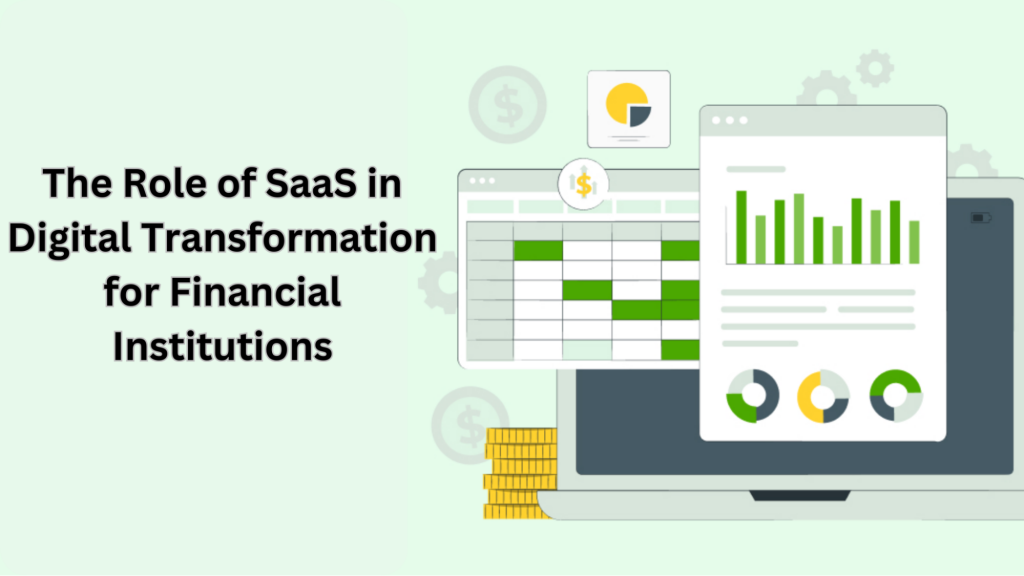In an era dominated by technological advancements, the financial industry is undergoing a significant transformation through the adoption of Software as a Service (SaaS).
As financial institutions strive to enhance their operational efficiency, reduce costs, and meet evolving customer expectations, SaaS emerges as a pivotal player in driving digital transformation.
This article explores the multifaceted role of SaaS in reshaping the landscape of financial institutions, shedding light on its benefits, challenges, and future implications.

Understanding Digital Transformation In Financial Institutions
Digital transformation in financial institutions involves the integration of digital technologies to fundamentally change how they operate and deliver value to customers.
This paradigm shift is driven by the need for agility, improved customer experiences, and staying competitive in a rapidly evolving market.
Here’s a breakdown of comprehensive aspects to understand the importance of SaaS software in financial institutions:
- Evolution of Financial Services: Initiate by painting a vivid picture of how financial services have evolved over time. From traditional brick-and-mortar establishments to the dawn of online banking, illustrate the seismic shifts that have shaped the industry.
- Technological Disruption: Highlight the pivotal role of technology in revolutionising financial operations. Explore how the advent of digital solutions, mobile apps, AI, blockchain, and data analytics has reshaped the financial landscape.
- Customer Expectations and Behaviours: Dive into the changing preferences and behaviours of customers. Unveil the demand for seamless, personalised, and convenient financial services, emphasising the shift towards digital platforms for banking, investments, and transactions.
- Need for Agility and Innovation: Discuss the driving forces behind the push for digital transformation in financial institutions. Elaborate on the necessity to be nimble in adapting to market trends, regulatory changes, and the rising competition from fintech disruptors.
- Enhanced Customer Experience: Detail the significance of customer-centricity in the digital era. Explain how financial institutions are leveraging technology to create tailored experiences, focusing on user-friendly interfaces, personalised services, and 24/7 accessibility.
- Data as a Game Changer: Unveil the power of data in the financial realm. Discuss how data analytics, AI, and machine learning are transforming decision-making processes, risk assessment, and the creation of predictive models for financial forecasting.
- Regulatory Landscape and Compliance: Shed light on the stringent regulatory environment that governs financial institutions. Detail the challenges and opportunities presented by regulations, emphasising the need for compliance in a digital-first world.
- Cultural Shift and Organizational Adaptation: Touch upon the internal changes within financial institutions. Explain how a digital transformation necessitates cultural shifts, including upskilling employees, fostering innovation, and embracing a mindset of continuous adaptation.
- Ecosystem Collaboration and Partnerships: Highlight the emergence of collaborations between traditional financial institutions and tech innovators. Explore the rise of partnerships, joint ventures, and ecosystem collaborations to leverage each other’s strengths in the digital space.
- Risks and Security Concerns: Acknowledge the potential risks associated with digital transformation, including cybersecurity threats, data breaches, and vulnerabilities. Discuss how institutions mitigate these risks while ensuring robust security measures.
- Future Roadmap and Trends: Conclude by peeking into the crystal ball. Discuss upcoming trends like decentralised finance (DeFi), quantum computing, and augmented reality in financial services, hinting at the potential future roadmap for digital transformation.
Six Lucrative Benefits Of Saas Software In Digital Transformation For Financial Institutions
1. Accessibility Anywhere, Anytime
Imagine a world where your financial tools aren’t tied to an office desk. SaaS paints that reality.
It’s the genie granting access to software applications from any corner of the globe with a stable internet connection.
Financial wizards crunch numbers from their favorite coffee shops, bankers seal deals from remote islands – the possibilities are boundless.
On the other hand, Cloud-based SaaS solutions facilitate seamless collaboration among geographically dispersed teams.
This is particularly valuable for financial institutions with multiple branches or global operations.
Although Quad Education is an Edtech company and not a financial institution, it serves as a great example of how companies can use SaaS solutions to create and manage a global team.
2. Cost-Effective Flexibility
The classic tug-of-war between quality and cost! With SaaS, financial institutions savor the best of both worlds.
No more splurging on pricey hardware or software updates. It’s a pay-as-you-go paradise, allowing institutions to scale their software usage according to needs.
Tightening belts where necessary, splurging where it counts – it’s financial management nirvana.
3. Upgraded Security Armor
Security breaches lurking in the shadows? SaaS is the knight in shining armor.
Providers lock horns with security threats, shelling out hefty sums to fortify their platforms.
Financial institutions reap the rewards without bearing the weight of fortification. It’s a win-win – fortified data without the sleepless nights.
4. Seamless Updates & Maintenance
Remember those pesky software updates that plagued your workflow? SaaS flips the script.
It’s a seamless ballet of updates and maintenance, all handled by the providers.
Financial institutions revel in hassle-free updates, ensuring they’re always armed with the latest tech arsenal without lifting a finger.
5. Rapid Deployment & Innovation:4. Seamless Updates & Maintenance
Remember those pesky software updates that plagued your workflow? SaaS flips the script.
It’s a seamless ballet of updates and maintenance, all handled by the providers.
Financial institutions revel in hassle-free updates, ensuring they’re always armed with the latest tech arsenal without lifting a finger.
6. Scalability
In a world where change is the only constant, flexibility reigns supreme. SaaS isn’t just scalable; it’s scalability on steroids.
Financial institutions effortlessly adjust their software usage, whether scaling up for peak seasons or downsizing during lulls. It’s the flexibility dance, and SaaS leads the waltz.
Challenges & Considerations
Legacy Systems Integration
- Detail the challenge of integrating new digital systems with existing legacy infrastructure.
- Explore the complexities involved in ensuring a smooth transition without disrupting ongoing operations.
- Discuss strategies to bridge the gap between old and new systems while maintaining functionality and data integrity.
Data Security and Privacy Concerns
- Highlight the paramount importance of safeguarding sensitive financial data in a digital landscape.
- Discuss the evolving cybersecurity threats and the challenges financial institutions face in securing data against breaches.
- Explore the regulatory requirements related to data privacy (e.g., GDPR, CCPA) and their impact on digital transformation strategies.
Cultural Resistance and Change Management
- Examine the challenges associated with cultural shifts within institutions when embracing digital transformation.
- Discuss resistance to change among employees, including training needs, mindset shifts, and organizational buy-in.
- Explore effective change management strategies to foster a culture of innovation and adaptability.
Regulatory Compliance and Governance
- Detail the intricate web of regulatory requirements governing financial institutions.
- Discuss the challenge of ensuring compliance with evolving regulations while implementing digital solutions.
- Explore the need for robust governance frameworks to navigate regulatory complexities effectively.
Scalability and Flexibility Issues
- Highlight the challenge of ensuring scalability and flexibility in digital solutions to meet changing business demands.
- Discuss how rigid systems may hinder an institution’s ability to adapt quickly to market shifts or scale operations.
- Explore strategies to design scalable and flexible digital infrastructure for long-term sustainability.
Customer Trust and Experience
- Address the importance of maintaining customer trust while undergoing digital transformation.
- Discuss potential challenges in delivering a seamless customer experience amidst technological changes.
- Explore strategies to balance innovation with customer expectations, ensuring a smooth transition without compromising trust.
Vendor Management and Partnerships
- Discuss the complexities involved in managing multiple vendors and partnerships in the digital ecosystem.
- Explore challenges related to vendor selection, service level agreements (SLAs), and ensuring interoperability among different systems.
- Highlight strategies for effective vendor management and fostering beneficial partnerships.
Real-World Examples of SaaS Software In Financial Services
Customer Relationship Management (CRM)
SaaS-based CRM solutions empower financial institutions to manage customer relationships efficiently, providing insights that enhance personalised services and drive customer satisfaction.
Risk Management and Compliance
SaaS platforms specialized in risk management and compliance enable financial institutions to navigate complex regulatory landscapes, ensuring adherence to industry standards and minimizing compliance risks.
Data Analytics and Business Intelligence
Leveraging SaaS for data analytics and business intelligence allows financial institutions to gain actionable insights, make informed decisions, and stay ahead in a data-driven environment.
The Future Implications of SaaS in Financial Institutions
As technology continues to evolve, the role of SaaS in the digital transformation of financial institutions is expected to expand further. The integration of artificial intelligence, machine learning, and blockchain technologies into SaaS solutions will likely redefine how financial services are delivered and consumed.
Conclusion
In conclusion, SaaS is a catalyst for digital transformation in financial institutions, offering a myriad of benefits that extend beyond cost savings.
The agility, scalability, and efficiency provided by SaaS solutions position financial institutions to thrive in an increasingly competitive and technology-driven landscape.
While challenges exist, the strategic adoption of SaaS, coupled with robust risk management and implementation strategies, can empower financial institutions to unlock new possibilities and better serve their clients in the digital age.






















Leave a comment!